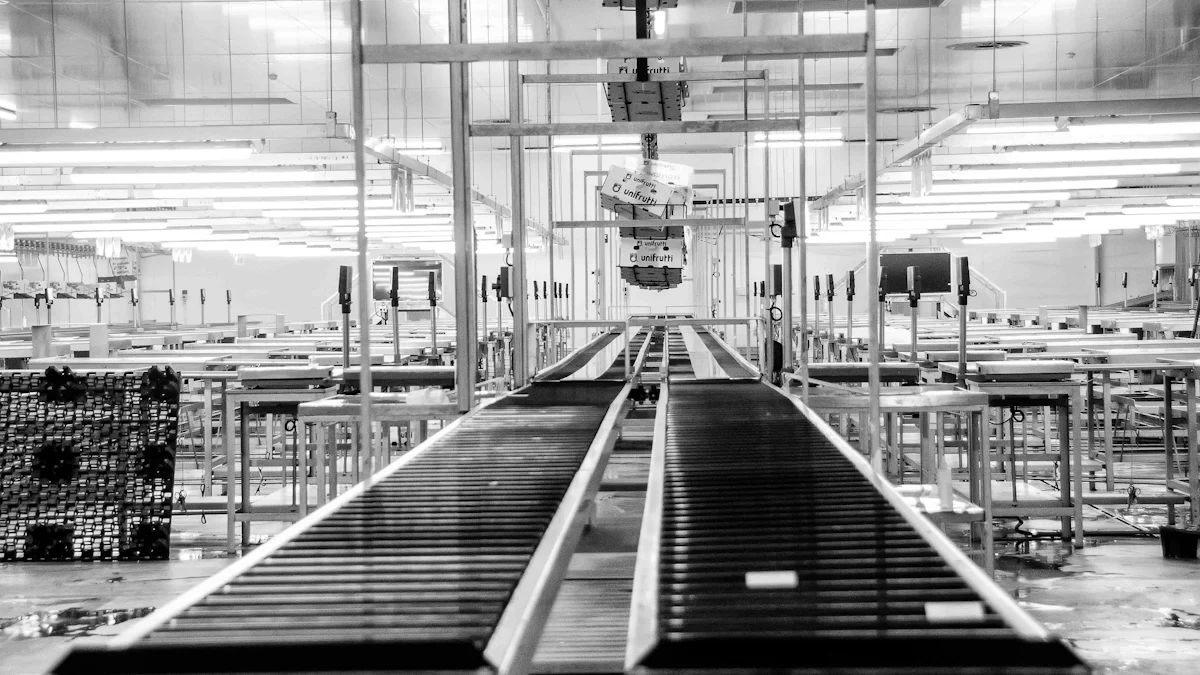
Choosing the right Button Battery ODM FACTORY plays a crucial role in determining the success of a product. This decision directly impacts the quality of the button batteries, which in turn affects the performance and reliability of the final product. A well-chosen factory ensures that the batteries meet industry standards, providing a competitive edge in the market. Companies must carefully evaluate potential factories to ensure they align with their quality expectations and business goals. By selecting the right partner, businesses can enhance their product offerings and achieve greater market success.
Understanding ODM Batteries
Definition and Characteristics
ODM batteries, or Original Design Manufacturer batteries, represent a unique approach in the manufacturing sector. These batteries are produced by a factory that designs and manufactures products based on the specifications provided by another company. This method allows businesses to leverage the expertise and resources of the Button Battery ODM FACTORY without investing heavily in their own production facilities. ODM batteries often feature specific characteristics tailored to meet the needs of various applications, ensuring compatibility and performance.
Advantages of ODM Batteries
Customization Opportunities
ODM batteries offer significant customization opportunities. Companies can work closely with the manufacturer to develop batteries that meet their precise requirements. This collaboration enables the creation of unique products that stand out in the market. Customization can include adjustments in size, capacity, and even chemical composition, allowing businesses to cater to niche markets or specific consumer demands.
Innovation Potential
The innovation potential of ODM batteries is immense. By partnering with an experienced manufacturer, companies can access cutting-edge technology and innovative design solutions. This partnership fosters the development of advanced battery solutions that can lead to improved performance and new product features. The ability to innovate quickly and efficiently gives businesses a competitive advantage in rapidly evolving markets.
Cost Efficiency
Cost efficiency remains a major advantage of ODM batteries. By outsourcing production to a specialized factory, companies can reduce manufacturing costs significantly. This approach eliminates the need for large capital investments in production facilities and equipment. Additionally, economies of scale achieved by the ODM factory can lead to lower per-unit costs, making it a financially attractive option for businesses of all sizes.
OEM vs. ODM Batteries
Key Differences
Design and Manufacturing Control
OEM, or Original Equipment Manufacturer, batteries offer companies significant control over design and manufacturing. They provide the opportunity to create products from scratch, ensuring that every detail aligns with the company’s vision. This control extends to the choice of materials, design specifications, and production processes. Companies can ensure that the final product meets their exact standards and requirements.
In contrast, ODM batteries involve a different approach. The ODM factory handles most of the design and manufacturing processes. Companies provide specifications, but the factory uses its expertise to bring the product to life. This method reduces the level of control companies have over the production process. However, it allows them to benefit from the factory’s experience and resources.
Branding and Ownership
Branding and ownership represent another key difference between OEM and ODM batteries. With OEM batteries, companies retain full ownership of the design and brand. They can market the product under their own name, building brand recognition and loyalty. This ownership extends to intellectual property rights, ensuring that the company maintains control over its innovations.
ODM batteries, on the other hand, often involve shared branding. The factory may retain some rights to the design, limiting the company’s ability to claim full ownership. This arrangement can affect how the product is marketed and perceived by consumers. Companies must carefully consider these factors when choosing between OEM and ODM options.
Comparison Chart
To better understand the differences between OEM and ODM batteries, consider the following comparison chart:
| Feature | OEM Batteries | ODM Batteries |
|---|---|---|
| Design Control | Full control over design | Limited control, factory-led design |
| Manufacturing Control | Complete oversight of production | Factory manages production |
| Brand Ownership | Full ownership and branding rights | Shared branding, limited ownership |
| Customization | High level of customization | Customization based on factory capabilities |
| Cost | Higher initial investment | Lower initial costs, cost-efficient |
| Innovation | Driven by company | Driven by factory expertise |
This chart highlights the primary distinctions between OEM and ODM batteries. Companies must weigh these factors carefully to determine which option best suits their needs and goals.
Criteria for Selecting the Right Button Battery ODM FACTORY

Choosing the right Button Battery ODM FACTORY involves evaluating several critical criteria. These factors ensure that the factory aligns with the company’s quality expectations and business objectives.
Quality Standards
Certifications and Compliance
A reputable Button Battery ODM FACTORY must hold relevant certifications. These certifications demonstrate adherence to industry standards and regulations. Companies should verify that the factory complies with international safety and environmental guidelines. This compliance ensures that the batteries produced are safe and reliable for consumer use.
Quality Control Processes
Effective quality control processes are essential in a Button Battery ODM FACTORY. The factory should implement rigorous testing procedures at every production stage. These processes help identify defects early, ensuring that only high-quality batteries reach the market. Companies should inquire about the factory’s quality assurance measures to guarantee consistent product excellence.
Production Capabilities
Technology and Equipment
Advanced technology and equipment play a vital role in battery manufacturing. A Button Battery ODM FACTORY equipped with state-of-the-art machinery can produce batteries with precision and efficiency. Companies should assess the factory’s technological capabilities to ensure they meet the demands of modern battery production.
Scalability and Flexibility
Scalability and flexibility are crucial for meeting varying production demands. A capable Button Battery ODM FACTORY can adjust its production volume to accommodate changes in demand. This flexibility allows companies to respond swiftly to market trends and consumer needs. Evaluating the factory’s ability to scale production ensures long-term partnership viability.
Cost-Effectiveness
Pricing Models
Understanding the pricing models offered by a Button Battery ODM FACTORY is essential. Transparent pricing structures help companies budget effectively and avoid unexpected costs. Companies should compare different factories’ pricing models to find the most cost-effective solution that meets their quality standards.
Value for Money
Value for money goes beyond just the price. It encompasses the overall benefits received from the partnership with the Button Battery ODM FACTORY. Companies should consider factors such as product quality, service, and support when evaluating value. A factory that offers excellent value for money contributes to the company’s profitability and success.
Communication and Support
Effective communication and robust support are vital when selecting a Button Battery ODM FACTORY. Companies should prioritize factories that demonstrate responsiveness and transparency. Quick responses to inquiries and clear communication about production processes build trust and facilitate smooth collaboration. Transparency in operations ensures that companies remain informed about every stage of the manufacturing process, reducing the likelihood of misunderstandings or errors.
Responsiveness and Transparency
Responsiveness reflects a factory’s commitment to customer service. Factories that respond promptly to questions and concerns show dedication to maintaining strong client relationships. This attentiveness helps address issues swiftly, minimizing disruptions in production. Transparency complements responsiveness by providing clients with detailed insights into production timelines, potential challenges, and solutions. A transparent factory keeps clients informed, fostering confidence in the partnership.
Language and Cultural Considerations
Language and cultural considerations play a significant role in international collaborations. Companies should assess the factory’s ability to communicate effectively in the preferred language. Miscommunications due to language barriers can lead to costly mistakes. Additionally, understanding cultural differences enhances collaboration. Factories that respect and adapt to cultural nuances create a more harmonious working environment, which can lead to more successful outcomes.
Long-term Partnership Potential
Establishing a long-term partnership with a Button Battery ODM FACTORY requires evaluating reliability and trustworthiness. Companies should seek factories with a proven track record and solid reputation. These factors indicate the factory’s ability to consistently deliver high-quality products and maintain strong business relationships over time.
Reliability and Trustworthiness
Reliability ensures that the factory meets production deadlines and quality standards consistently. A reliable factory minimizes risks associated with delays or defects, ensuring that companies can meet their market commitments. Trustworthiness involves ethical business practices and honesty in dealings. Factories that uphold these values build lasting partnerships based on mutual respect and confidence.
Track Record and Reputation
A factory’s track record provides insight into its performance history. Companies should investigate past projects and client feedback to gauge the factory’s capabilities. A positive reputation in the industry often indicates a factory’s commitment to excellence and customer satisfaction. By choosing a factory with a strong track record and reputation, companies can enhance their chances of a successful and enduring partnership.
Understanding the differences between OEM and ODM batteries is crucial for making informed decisions. Choosing a Button Battery ODM FACTORY offers numerous benefits, including cost efficiency and innovation potential. Key criteria such as quality standards, production capabilities, and communication support guide the selection process. By carefully evaluating these factors, companies can ensure product success and maintain a competitive edge in the market.
Post time: Nov-21-2024




